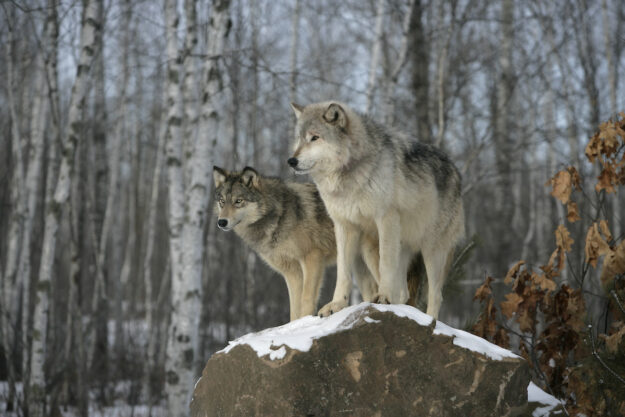Widgetized Section
Go to Admin » Appearance » Widgets » and move Gabfire Widget: Social into that MastheadOverlay zone
Opinion: Push for paws on ground may have cost hearts, minds in Colorado’s ongoing wolf saga

As a natural resources-oriented journalist for over 40 years, I’ve been blessed with opportunities to learn and grow in my work – especially during my decade-long stint in Wyoming, covering the Greater Yellowstone Ecosystem and what can be found there: grizzly bears, super-volcanoes, elk and wolves.
Accordingly, I have some thoughts I’d like to share about the recent reintroduction of wolves into Colorado. Basically, this was not well thought out or executed.
For the wolf-lovers and environmentalists in the Front Range, who successfully sold Colorado voters on the idea, I have a bouquet and a brick-bat. My compliments on the 2020 referendum that directed Colorado Parks & Wildlife (CPW) to reintroduce wolves into Western Colorado by 2023. Trouble is, while you’ve won a critical battle, you could lose the war to win over the hearts and minds of citizens, hunters, ranchers, rural residents, outfitters, and government officials who feel this deal was rammed down their throats by city folks caught up in a romantic idea, with little or no practical idea of the realities.
I suspect that organizers and advocates of the wolf referendum were too focused on getting paws on the ground, feeling that they could wrestle with problems as they emerged.
Well, guess what, Skippy? The problems are already here and more are coming.
Paws on ground is not a formula for long-term success, because the population of the Western Slope is anxious and pretty freaked out.
Some residents are already at the 3S stage: shoot wolves, shovel them deep, and shut up about extra-legal killings. Many other folks are taking a wait-and-see approach to see how wolf management and wolf depredation of livestock are handled.
From 2020 to 2023, there was not enough time, planning, budgeting, public education, or public relations to adequately quell this growing freak out. Fortuneatly, that can be corrected, but it will take much more work and money at this stage, than it would have back in 2000.
First of all, Gov. Jared Polis (D-CO) needs to whip out his magic executive order pen and create a working, inter-departmental group that includes CPW, Agriculture, Education, Tourism, higher education, and Extension agents from Colorado State University. The immediate goal is tamping down the freak-out level on the Western Slope, as well as generating ideas and cooperative programs for the longer term.
That’s where you need the state legislature, to tap new income streams, and create budgets and programs to educate citizens that it is possible to co-exist with wolves and that wolves can benefit Colorado ecosystems throughout the state. A guiding dictum has to be that the entire burden of wolf education and management cannot be solely on the shoulders of CPW.
Looking at how state and federal agencies have responded to growing wolf populations in the Great Lakes and northwestern states, here are more suggestions:
- Remove ALL sick, injured, or dead livestock as soon as possible. They attract wolves. No attractants, the odds go down that wolves will come visiting.
- Increase the budget for CPW. Although staff have been frantically reading up on wolves, there are no top-rank wolf biologists/scientists on board. They don’t know what they don’t yet know, so they are in danger of reinventing the wheel and making mistakes other states have made. CPW should recruit/raid the best and the brightest from other state agencies. Find the best academics and put them on speed dial, and pay them to come in and lecture your people. Pay attention to successful programs for minimizing livestock predation. Dead livestock and dead wolves are both failures to be avoided.
- When seeking more wolves to transplant into Colorado, put a higher priority on ones who have not killed livestock. That’s a difficult lesson to unlearn.
- Buy and assemble the equipment and supplies to create one, two, or three comprehensive wolf-deterrence kits: solar panels and batteries, electric fences with fladry strips, motion-sensors to trigger lights, horns, and spooky balloon men to pop out of the grass. Such kits, with in-depth training, should be loaned out to ranchers as soon as wolves show up. When the wolves move on, lend the equipment to the next rancher visited by wolves.
- Recruit, train, and supervise shepherds and range riders, as state employees, to help with wolf deterrence. Follow the wolves to the next areas they visit. Repeat and rinse.
- Recruit livestock guardian dog breeders to work with the state on maintaining or improving breeding lines and train dogs for the various roles expected: protection, pursuit or combat.
- Because wolves will expand their territories, how does Colorado prepare Estes Park for wolves in Rocky Mountain National Park; teach Boulder hikers that letting Fluffy run ahead on a mountain trail is not a good idea; or persuade San Luis Valley residents to adopt best practices well before wolves arrive?
Last week, you may have seen news articles about how CPW leaders were getting their butts masticated by mightily-miffed legislators who are none too happy about where and how the wolves were released in Colorado counties, and how Walden wolves were killing local livestock, with CPW reluctant to define how many killings will result in wolves being removed by lethal means.
That’s a good sign that things are not going well and need to change.
Otherwise, the 3Ss will become commonplace.
Editor’s note: This opinion piece first appeared on the Colorado Times Recorder website. Brodie Farquhar is misplaced Scot based in Hayden, Colorado. He is an award-winning journalist with 21 national, regional and state press associations, from Colorado, Arizona, Kansas, Washington and Wyoming.


